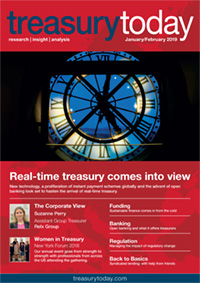Contents
- Editorial
- Time to reflect
- Insight & Analysis
- How soon is now? The value of real-time treasury operations
- Adam Smith Awards
- And the winner is…
- Women in Treasury
- Women in Treasury New York Forum 2018
- Funding
- A natural development: sustainable finance making a difference
- The Corporate View
- Corporate View: Suzanne Perry, RELX Group
- Women in Treasury
- Women in Treasury: from insight to action Geneva
- Banking
- Corporate treasurers urged not to ignore benefits of open banking
- Webinar Report: BNP Paribas
- Adam Smith Awards 2021
- Regulation
- Managing the impact of regulatory change
- Back to Basics
- Stronger together: the power of syndicated lending
- Question Answered
- Question Answered: The future of treasury
- Market View
- 2019 – breaking point?
Editorial
Time to reflect
In ‘The Gumball Rally’, a 1970s comedy film about an illegal US coast-to-coast road race, the Ferrari Daytona-driving Italian, Franco Bertollini, rips off his rear-view mirror exclaiming “what’s behind doesn’t matter”.
Entertainment value aside, most racing drivers would disagree. Of course, they need superhuman ‘in-the-moment’ skill to stay ahead of the competition but they also need to know what the other drivers are doing.
To assist, modern racing cars augment mirrors with pit radio and a host of high-tech telemetry, giving the driver a concise but highly accurate and timely picture of the state of their own vehicle and what’s going on around them. From this they can plan their race (if team orders don’t interfere…). This may sound familiar.
Whilst few treasurers, if any, experience quite the same level of sustained adrenalin flow as racing drivers in everyday situations, when things change quickly, the pressure ramps up and the treasurer’s skill and experience must come to the fore.
An almost superhuman awareness of what’s going on, often on an expansive international stage, is vital. Boosting the reflective power of the ‘mirror’ with modern technology allows every situation to become clearer, and the decisions made that bit sharper. Quite simply, more than ever, treasurers need to be the financial ‘all-seeing eye’.
The International Monetary Fund (IMF) and Organisation for Economic Cooperation and Development (OECD) are downgrading their outlooks for the US in 2019, mindful of the escalating trade war, the Fed’s resolve to continue raising interest rates, and a likely sharp increase in oil prices caused by low global spare capacity, sanctions on Iranian exports, and political uncertainty in Saudi Arabia. There is the ongoing Brexit saga between the UK and the EU, and now the UN Economic Analysis and Policy Division has warned that improved economic performance in the global economy “is increasingly being overshadowed by heightened risks and humanitarian concerns”.
For treasurers, managing economic and political uncertainty is now part of the job. Being effective in these arenas demands ever-greater awareness of trading conditions. In this issue, we look at the concept of real-time treasury, asking how it can help both decision-making and operational efficiency in the here-and-now.
Also, given that the world’s governments and authorities are not easing up on their attempts to manage the vagaries of the financial markets, we explore how best to identify, plan for and implement regulatory change.
Of course, all competitive arenas demand that its participants look every which way, including ahead. With the Paris Agreement and 2030 Agenda for Sustainable Development including a firm commitment to align financial flows with climate-resilience, our investigation of green finance and sustainability is a timely reminder for treasurers that full awareness must include what lies ahead.


